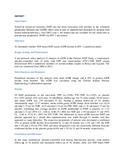| dc.description.abstract | Importance:
Tenofovir disoproxil fumarate (TDF) use has been associated with declines in the estimated glomerular filtration rate (eGFR) when used as part of antiretroviral treatment by persons with human immunodeficiency virus (HIV) type 1, but limited data are available for risk when used as preexposure prophylaxis (PrEP) for HIV-1 prevention.
Objective:
To determine whether TDF-based PrEP causes eGFR decline in HIV-1-uninfected adults.
Design, Setting, and Participants:
A per-protocol safety analysis of changes in eGFR in the Partners PrEP Study, a randomized, placebo-controlled trial of daily oral TDF and emtricitabine (FTC)-TDF PrEP among heterosexual HIV-1-uninfected members of serodiscordant couples in Kenya and Uganda. The trial was conducted from 2008 to 2012.
Main Outcomes and Measures:
Predefined outcomes of this analysis were mean eGFR change and a 25% or greater eGFR decline from baseline. The eGFR was calculated using the Chronic Kidney Disease Epidemiology Collaboration equation.
Results:
Of 4640 participants in the once-daily TDF (n = 1548), FTC-TDF (n = 1545), or placebo (n = 1547) groups, 63% were men. At enrollment, median age was 35 years (range, 18-64 years), and mean eGFR was 130 mL/min/1.73 m2. During a median follow-up of 18 months (interquartile range 12-27 months), mean within-group eGFR change from baseline was +0.14 mL/min/1.73 m2 for TDF, -0.22 mL/min/1.73 m2 for FTC-TDF, and +1.37 mL/min/1.73 m2 for placebo, translating into average declines in eGFR attributable to PrEP vs placebo of -1.23 mL/min/1.73 m2 (95% CI, -2.06 to -0.40; P = .004) for TDF and -1.59 mL/min/1.73 m2 (95% CI, -2.44 to -0.74; P < .001) for FTC-TDF. The difference in mean eGFR between PrEP and placebo appeared by 1 month after randomization, was stable through 12 months, and then appeared to wane thereafter. The respective proportions of persons who developed a confirmed 25% or greater eGFR decline from baseline by 12 and 24 months was 1.3% and 1.8% for TDF and 1.2% and 2.5% for FTC-TDF, and these frequencies were not statistically different from the confirmed decline in the placebo group (0.9% and 1.3% by 12 and 24 months, respectively).
Conclusions and Relevance:
In this large randomized, placebo-controlled trial among heterosexual persons, with median follow-up of 18 months and maximum follow-up of 36 months, daily oral TDF-based PrEP resulted in a small but nonprogressive decline in eGFR that was not accompanied by a substantial increase in the risk of clinically relevant (≥25%) eGFR decline. | en_US |

